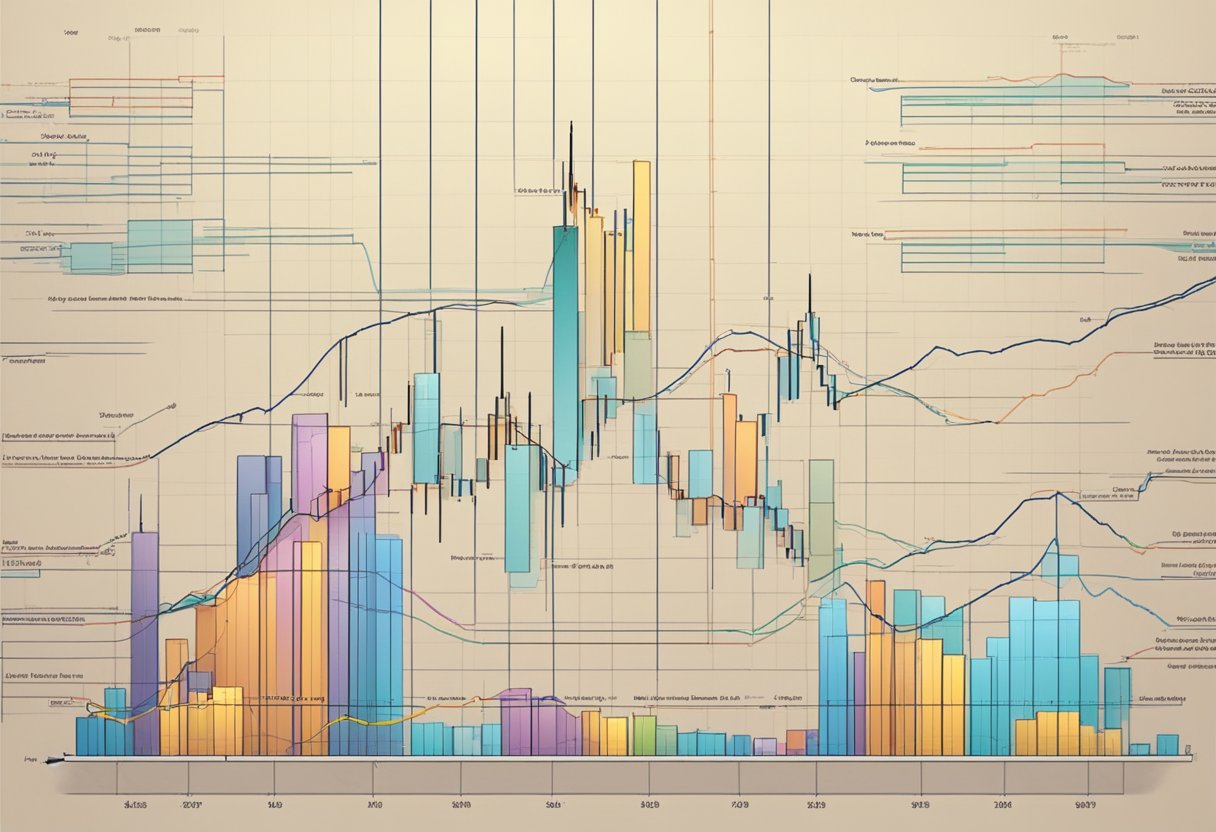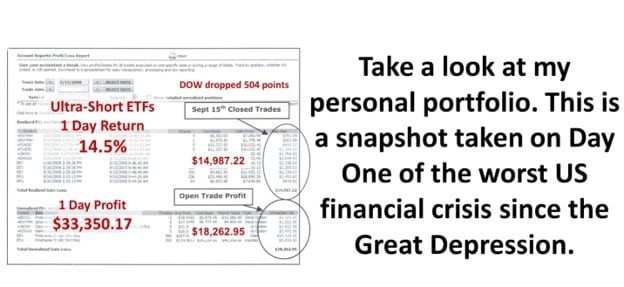Bitcoin market cycles have become a point of interest for investors and enthusiasts alike, as understanding these cycles can lead to better long-term strategies and decision-making. In the cryptocurrency world, Bitcoin remains the leading digital asset by market capitalization, setting the pace for the rest of the market. Familiarizing oneself with the basics of market cycles, the impact of significant events, and the interplay of human emotions can set the stage for a deeper comprehension of Bitcoin’s value fluctuations.
Over the years, Bitcoin has gone through various market cycles, typically lasting around four years, with the halving event believed to be at the center of each process. In these market cycles, periods of bullish growth are often followed by bearish downturns, showing the market’s cyclical nature. Understanding Bitcoin’s price movements and being aware of market indicators can be crucial for long-term investors and short-term traders, helping them navigate the often volatile cryptocurrency markets more strategically.
Key Takeaways
- Understanding Bitcoin market cycles equips investors with insights for better decision-making.
- Market cycles consist of bull and bear phases, driven by various factors, including significant events and human emotions.
- Awareness of market indicators and a long-term outlook can be crucial for successfully navigating the volatile cryptocurrency space.
Understanding Bitcoin and Cryptocurrency

Bitcoin is the pioneering cryptocurrency that introduced the idea of decentralized digital currencies. It operates on a technology called blockchain, which ensures transparency and security. The creation of Bitcoin has paved the way for the emergence of alternative coins, commonly referred to as altcoins, which also function on blockchain technology.
Due to technical limitations, many altcoins have originated to fill niches that Bitcoin cannot cater to. For example, Ethereum introduced intelligent contracts and made it possible to build decentralized applications (dApps), while Ripple aims to provide a global payment network for financial institutions.
Understanding cryptocurrencies’ underlying technology and mechanics can help make informed decisions in the crypto market. Market cycles play a significant role in cryptocurrencies’ price movements, including Bitcoin and altcoins. These cycles include four phases, namely the accumulation, markup, distribution, and markdown phases.
Analyses of historic cycles for Bitcoin suggest a pattern in price fluctuation based on market sentiment, technology advancements, and regulatory changes. Recognizing these patterns can help investors make informed decisions about their cryptocurrency holdings.
Traditional investment strategies, such as diversification and dollar-cost averaging, can also apply to cryptocurrency investments. A balanced portfolio should include a mix of Bitcoin and altcoins, which can offer growth opportunities and reduce overall risk.
When investing in cryptocurrencies, staying informed about market trends and technological updates is essential. A confident and knowledgeable approach will help maintain a clear and neutral perspective, ensuring better financial decisions in the volatile world of cryptocurrencies.
Basics of Market Cycles

Market cycles are essential concepts in understanding the price movements of assets, such as Bitcoin. These cycles generally consist of four stages: uptrend, downtrend, consolidation, and cycle completion. This section will explore these stages and their significance in Bitcoin market cycles.
An uptrend is a period where the price of Bitcoin increases consistently. This stage is also known as the bull market. During an uptrend, investor optimism and buoyant news drive demand for the digital asset, pushing its value higher. The increased demand results in a higher trading volume and price.
On the contrary, a downtrend describes a period when the price of Bitcoin declines consistently. This stage is known as the bear market. During a downtrend, negative news, regulatory changes, or profit-taking among investors may cause a decline in demand, leading to lower prices and trading volumes.
Between the uptrend and downtrend stages lies the consolidation phase. This stage is characterized by a period of relative stability, where the price of Bitcoin moves sideways without significant upward or downward movement. Traders and investors may view the consolidation phase as a period of indecision or as an opportunity to accumulate Bitcoin in anticipation of the next market cycle.
The final stage of a Bitcoin market cycle is cycle completion. During this stage, market conditions that previously drove the price in a specific direction may become exhausted or revert to a neutral state. This stage often marks the end of a bear or bull market, setting the stage for a new market cycle.
Understanding Bitcoin market cycles is crucial for investors and traders. Recognizing the different stages of a market cycle can help anticipate future price movements, make more informed decisions, and ultimately maximize profits while minimizing risks.
How Bitcoin Price is Affected

The price of Bitcoin is a product of various factors, ranging from market forces to external events. A key influence on Bitcoin price is the market cycle, which typically lasts around four years according to its history. The process is marked by halving events that occur roughly every four years, which significantly impact the cryptocurrency’s valuation.
Bitcoin’s price action, as with most cryptocurrencies, is subject to supply and demand dynamics. The halving events are crucial in controlling the supply side by reducing the block reward for miners. As the dividends decrease, the restricted supply tends to push the price upward if demand remains strong or increases. The four phases of the crypto market cycle – accumulation, markup, distribution, and markdown – also contribute to the way Bitcoin’s price behaves in the market.
Throughout its price history, Bitcoin has experienced multiple fluctuations in valuation, with some reaching all-time highs followed by sharp declines. These fluctuations can be observed on a logarithmic scale, which helps identify patterns and understand the relationship between various market cycles. The cycle usually starts with a rapid price rise, surpassing previous all-time highs, and then experiences a correction where the price drops significantly.
Institutional involvement can affect price action, as seen in the Forbes article that mentioned the price surge of Bitcoin to $35,000 was not driven by retail investors but by institutional players like BlackRock. Additionally, social metrics and media attention can impact sentiment, leading to shifts in demand and subsequent price changes.
In summary, the price of Bitcoin is influenced by various elements, including its market cycle, halving events, supply and demand dynamics, price action, and external factors like institutional involvement and social metrics. These factors culminate in a continuously evolving landscape for Bitcoin, as the cryptocurrency navigates valuation shifts and all-time highs throughout its journey.
Market Phases: Bull and Bear Markets

In Bitcoin and cryptocurrencies, two primary market phases dominate the landscape: the bull market and the bear market. These market phases represent significant trends in value and investor sentiment, which drive the overall performance of a cryptocurrency, like Bitcoin.
During a bull market, Bitcoin’s price tends to rise, driven by positive sentiment and market optimism. In this phase, investors are confident in the future performance of the cryptocurrency, which often leads to increased demand and, thus, higher prices. This phase can last for several months or even years and is typically characterized by upward solid momentum in market prices, low volatility, and consistent growth.
In contrast, a bear market signifies a prolonged period of declining prices for Bitcoin. Market sentiment shifts to a more pessimistic outlook, with investors becoming increasingly concerned about potential losses, leading to decreased demand and lower costs. Bear markets can also last for months or years, often accompanied by high volatility, shrinking trading volumes, and wide-ranging price fluctuations.
Market sentiment is crucial in determining the predominance of bull or bear markets, as it dramatically influences investor behavior and decision-making. Positive emotion can fuel a bull market, as increased confidence leads to higher demand and buying pressure. Conversely, the negative view can trigger a bear market, as pessimism causes investors to sell off assets and exit positions in anticipation of further declines.
A crucial aspect of navigating Bitcoin market cycles is understanding trend reversals. Market trends can change abruptly, transitioning from bullish to bearish or vice versa. Identifying these reversals early can assist investors in making informed decisions and capitalizing on lucrative opportunities. Some common indicators to watch include a sudden spike or drop in trading volumes, a shift in market sentiment, and specific technical analysis patterns, such as head-and-shoulders or double tops and bottoms.
In summary, understanding the Bitcoin market cycles and the dynamics of bull and bear markets is essential for making well-informed investment decisions. Monitoring market sentiment, identifying trend reversals, and adapting to prevailing conditions can help investors navigate these cycles with confidence and clarity.
Human Emotion and Market Cycles

Role of Fear and Greed
Fear and greed are two powerful human emotions that play a significant role in market cycles, especially in the Bitcoin market. These emotions drive investors to make irrational decisions, often leading to market fluctuations. When the market is bullish, greed takes over, and people tend to invest more due to the fear of missing out. Conversely, fear intensifies when the market takes a downturn, leading to panic selling.
The cycle of fear and greed goes through various stages, such as hope, optimism, belief, and over-exuberance. The initial phase of hope marks the beginning of a potential bull run. Investors are cautiously optimistic and make smaller investments. As the market gains momentum, optimism grows, strengthening investor belief in the market’s potential. Over-exuberance takes center stage once the cycle’s peak is reached, leading to highly inflated valuations and excessive investments.
Understanding FOMO
FOMO, or Fear of Missing Out, is a powerful driving force behind market cycles. FOMO emerges during the stages of belief and over-exuberance, as investors witness the rapid market growth and get anxious about not being a part of the potential profits. This emotion prompts investors to make hasty decisions, often entering the market when prices are at their peak. As a result, individuals with FOMO may end up facing losses when the market starts to correct itself.
During the downward trend of market cycles, emotions like anxiety, doubt, and uncertainty come into play. As the market begins to fall, investors feel anxious about their investments and start to doubt the future performance of the market. This uncertainty can lead to panic selling, resulting in a self-reinforcing cycle of market decline.
In conclusion, human emotions play a vital role in forming and continuing Bitcoin market cycles. By understanding the feelings behind these cycles and recognizing the signs of fear, greed, and FOMO, investors can make more informed decisions and potentially avoid the pitfalls associated with emotionally driven investments.
Bitcoin Price Corrections and Retracement

Bitcoin market cycles are known for their volatility and price swings. During these cycles, it is common for Bitcoin to experience price corrections and retracements. A sentence refers to a price decline of at least 10% from its peak, whereas a retracement is a temporary price reversal within a more significant trend.
Price corrections and retracements are natural phenomena in the cryptocurrency market, as each upward move is eventually followed by consolidation or pullback. This process enables the market to establish a new base to build momentum for the next push. As the market matures, the severity of corrections and retracements may vary, often influenced by external factors such as market sentiment, news events, and regulatory updates.
Identifying the Bitcoin bottom, or the lowest point in a given correction, can be challenging. Traders and investors alike often attempt to estimate the probable bottom by using technical analysis tools, such as support and resistance levels, moving averages, and Fibonacci retracement ratios. However, it is essential to remember that these tools are based on historical patterns and cannot provide infallible predictions.
In the past, Bitcoin has experienced both mild and severe retracements. For example, during the 2016 halving cycle, the price retraced by 70% over a span of 270 days. This sort of retracement can shake investor confidence and lead to temporary panic selling. However, understanding the nature of market cycles can provide a more balanced perspective on the long-term potential of Bitcoin.
As an investor or trader in the Bitcoin market, knowing the potential for corrections and retracements is crucial for sound risk management. By understanding the market’s cyclical nature and maintaining a precise, knowledgeable, and neutral perspective, one can navigate these market cycles more effectively and make well-informed decisions.
Significant Market Events and Their Impact

When analyzing Bitcoin market cycles, key events provide valuable insights into the impact on the cryptocurrency’s price. One such event occurred in December 2017, when Bitcoin reached its all-time high. This exceptional peak was characterized by a parabolic and exponential rally, attracting investors worldwide.
The exponential rally led to all-time highs for Bitcoin rapidly, as the cryptocurrency gained widespread attention. With the surge in popularity, market sentiments turned highly bullish, and investors’ fear of missing out on potential profits prompted them to enter the market. This influx of investment, in turn, further fueled the exponential price increase. As Bitcoin seemed unstoppable, the market grew even more optimistic.
However, the parabolic trend could not be sustained indefinitely. As prices reached unsustainable levels, the market eventually experienced a significant correction, with Bitcoin prices plummeting. This sudden drop in value shocked many investors and raised questions about the cryptocurrency’s long-term viability.
Bitcoin’s market cycles demonstrated a stark contrast between the exponential rally and the eventual crash during this period. By analyzing these events, market participants can gain a better understanding of the factors that drive price fluctuations and become better equipped to make informed decisions in future cycles. By staying aware of historical trends and significant market events, investors can navigate the ever-evolving world of cryptocurrencies more confidently and knowledgeably.
Strategies for Long-Term Investors

Bitcoin market cycles play a crucial role in shaping investment strategies, especially for long-term investors. Understanding these cycles can help investors plan their investments wisely and make the most out of their holdings.
One of the primary strategies for long-term investors is to “hold” or hold on to their Bitcoin holdings. This approach involves buying and holding Bitcoin for an extended period, typically through multiple market cycles. The rationale behind this strategy is that Bitcoin’s value often increases exponentially over time, and holding onto it can lead to significant gains in the long run.
Long-term investors should also consider reinvesting their rewards. As Bitcoin’s value increases, investors might receive tips through activities like staking or mining. Reinvesting these rewards back into Bitcoin can further compound the gains and lead to even higher returns in the future.
Diversification is another essential aspect of long-term investment strategies. While Bitcoin has historically been a high-performing asset, allocating a portion of the investment to other cryptocurrencies or traditional assets, such as stocks or bonds, can provide a safety net during market downturns.
Lastly, long-term investors should pay attention to significant events in the Bitcoin market, such as halving cycles, which can impact the cryptocurrency’s value. Being aware of these events and adjusting investment strategies accordingly can help investors navigate market fluctuations and secure better gains in the long run.
By adopting a confident and knowledgeable approach, long-term investors can effectively navigate Bitcoin market cycles and maximize their rewards. It’s essential to stay informed, remain patient, and make well-reasoned decisions to ensure the best possible outcomes in the ever-evolving world of cryptocurrency investing.
Market Indicators and Their Interpretations
Market indicators play a crucial role in understanding the dynamics of the Bitcoin market cycle. One commonly used indicator is the market cap, which provides an estimate of the total value of all bitcoins in circulation. A rise in market cap usually signals increased interest and investment in Bitcoin, while a decline might suggest a bearish market sentiment.
Another important indicator is the win ratio, which compares the number of profitable days to the total number of trading days. A high win ratio indicates that more investors are gaining profits, which may be a sign of a healthy and upward-trending market.
In the context of market cycles, the 200-week moving average is a valuable tool for spotting potential market bottoms and entry points. When the Bitcoin price touches or goes below the 200-week moving average, it is often considered a strong buy signal, as it has historically coincided with market bottoms before significant price appreciation.
The Bitcoin index also offers valuable insights regarding the market cycles. Resistance and support levels at $10,000, $20,000, or higher peaks can explain possible retracement zones during a market cycle. Based on these levels, traders can gain valuable information on the strength of the bullish or bearish movements.
The concept of trade volume is another crucial factor that helps assess market momentum. An increase in trade volume might point toward a healthy uptrend, while a decrease could be a sign of diminishing buyer interest.
By assessing the probability of Bitcoin price movements, traders can make more informed decisions regarding their positions. One example of such an indicator is the Bitcoin Rainbow Price Chart Indicator, which assigns different colors to various price ranges. This visualization allows traders to estimate the likelihood of a price increase or decrease.
In conclusion, understanding market indicators and their interpretations is essential for navigating the complex world of Bitcoin market cycles. By combining various indicators, investors can gain valuable insights and make informed decisions about their positions in the market.
The Future of Bitcoin
Bitcoin market cycles have been crucial to the cryptocurrency’s growth and development. As we look into the future of Bitcoin, it is essential to understand how these market cycles could impact its value and adoption.
Probabilistically speaking, Bitcoin will likely continue its growth trend, as it has followed a pattern of peaks and corrections since its inception. The current market cycle, which began in early 2020, saw Bitcoin reach an all-time high of over $64,000 in April 2021 before experiencing a correction period, as reported by Choice. Market analysts continue to debate whether we are currently in a bull or bear market. However, understanding these cycles can help investors and users navigate the ever-evolving landscape of digital currencies.
Future trends in the Bitcoin market are also influenced by technological advances, regulations, and global economic factors. For example, Bernstein predicts that Bitcoin’s value could soar to $150,000 by mid-2025 as the cryptocurrency enters a new cycle, according to Business Insider. Developments in payment infrastructure and growing interest from institutional investors are expected to propel Bitcoin’s adoption and value in the coming years.
As the mainstream acceptance of Bitcoin increases, it is also expected to play a significant role in the volatile financial landscape. Bloomberg Intelligence analyst Jamie Coutts explores the connection between market volatility and the future of Bitcoin, suggesting that cryptocurrency has the potential to provide stability and new investment opportunities for individuals and institutions alike.
In conclusion, the future of Bitcoin will be influenced by numerous factors, including market cycles, technological advancements, and global economic developments. By understanding these dynamics, investors and users can make informed decisions about their involvement with this groundbreaking digital asset.
How can historical Bitcoin market cycles help with future predictions
While historical market cycles can provide valuable insights into potential trends, it’s essential to exercise caution when using past performance to predict future movements. Bitcoin and the broader crypto market are still relatively young compared to traditional financial markets, and numerous factors can influence market dynamics. It’s crucial to maintain a comprehensive understanding of the market, consider multiple factors, and remain flexible in the face of evolving market conditions.
The crypto asset market is highly emotional, noisy, and thus challenging to navigate. This has created significant information asymmetry among participants, which can be a boon to investors who can be level-headed and get proper signals. We are at an inflection point in a market that shows institutions are coming as critical infrastructure continues to come online.
The crypto asset market has since been primarily dominated by retail investors but indeed has also shown niche hedge funds in the mix. Interestingly enough, this once-in-a-lifetime market has demonstrated that not only has the average Joe not taken advantage of buying and selling opportunities, but even some of the most prominent hedge funds in the space did not have proper risk management.
If you are reading this article around the date of publishing, it is time you take notice of where we may be in the current market cycle. The chart below shows the past 3 Bitcoin market cycles, which consist of bull markets, bear markets, and accumulation phases. Based on this chart, we are entering a final re-accumulation phase before the next large bull market, which would likely propel Bitcoin far higher than the previous $20,000 all-time high.
It’s important to understand that this chart should not be taken as gospel but as a primary education reference point to help you understand market cycles. The re-accumulation phase may be shorter (or longer) than shown in the image.
Frequently Asked Questions
What are the stages of a typical Bitcoin market cycle?
A typical Bitcoin market cycle consists of several stages: accumulation, expansion, bull run, distribution, and bear market. During the accumulation phase, informed investors take positions, leading to an increase in demand and price. Expansion follows, characterized by growing interest and higher trading volumes. The bull run sees rapid price increases, attracting new investors, while the distribution phase marks the start of price instability and profit-taking. Finally, during the bear market, prices declined, and investor sentiment became negative until a new accumulation phase began.
How does Bitcoin halving events impact market cycles?
Bitcoin halving events, where the rewards for miners are halved, occur approximately every four years. These events generally lead to reduced inflation and increased demand for the cryptocurrency, resulting in bullish market cycles. However, it’s important to remember that halving events are only one-factor influencing market cycles and should not be solely relied upon for predictions.
What is the average duration of Bitcoin market cycles?
Bitcoin market cycles can vary, but historically, they have lasted between 1 and 4 years. The ROI and time of each process are diverse as well, with some seeing higher returns than others. It’s crucial to remember that past performance does not guarantee future results, and the duration of future cycles can vary significantly.
How do Bitcoin cycles compare to traditional financial processes?
Bitcoin cycles can be more volatile and shorter than traditional financial cycles. While conventional market cycles last several years to decades, Bitcoin cycles have been observed over relatively shorter timeframes. Additionally, Bitcoin’s price swings can be more pronounced, with more significant fluctuations than traditional assets.
What factors influence the different phases of a Bitcoin market cycle?
Various factors influence Bitcoin market cycles, including supply and demand dynamics, investor sentiment, global economic events, technological advancements, and regulatory changes. Additionally, events like network upgrades, halvings, and security issues can significantly affect the market. Market participants should consider these factors when analyzing cycles and making investment decisions.
Again, this market is highly emotional and causes most investors to focus on short-term price action instead of gathering high-quality information and positioning themselves correctly for more significant midterm or long-term price action. The crypto asset market and associated high-quality assets will likely continue to appreciate; don’t miss out on this once-in-a-lifetime opportunity due to low-quality information and short-term thinking.

Related Posts:
- How to Start Trading?
- How to Trade Cryptocurrency – For Beginners
- The Basics of a 401(K) Retirement Plan
- 5 Ways GIG Economy Workers Can Save for Retirement
- 4 Things You Must Know When Retirement

Dear Trader,
If you have just 6 minutes a day …
…then that’s enough time to “copy & paste” my team’s trade suggestions that make it possible for you to go after an extra $4,076, $4,780 or even as much as $6,018 in just six minutes a day!
Watch my training video and prove how it can help you achieve your financial goals.
I look forward to working with you!
Sincerely,

Chuck Hughes
Creator of the Award-Winning
Hughes Optioneering®

How to Create a Steady Income in Retirement
A Message from Chuck Hughes on how to create a continuous and steady income in retirement
I wanted to share this timely training on how to potentially bankroll your retirement in just 6 minutes per day thanks to my “6 Minute Income Secret.” Are you ready?
I’ll give you a little “sneak peek” at just one of the things I’ll be teaching you.
You’ll get an exclusive look at my portfolio, and I will share how I made $33,000 in a single day on what was a HORRIBLE day for most investors…

If this sounds good, make sure you attend the training, be ready to take some notes, and I’ll see you there.
This is going to be helpful for you…
Click Here To Get Access Your VIP Training Now
Sincerely,

Chuck Hughes
Creator of the Award-Winning
Hughes Optioneering®





